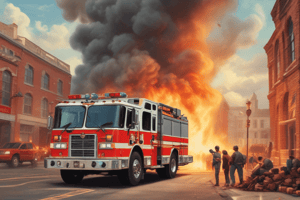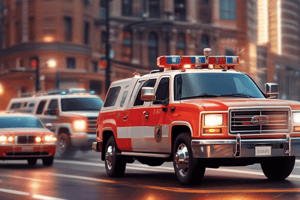Podcast
Questions and Answers
What is the effective date of the Standard Operating Guidelines?
What is the effective date of the Standard Operating Guidelines?
- April 1, 2022
- October 1, 2021
- April 1, 2017 (correct)
- October, 2024
When is the due for revision date of the Standard Operating Guidelines?
When is the due for revision date of the Standard Operating Guidelines?
- April 1, 2017
- October 1, 2021
- October, 2024 (correct)
- April 1, 2022
What is the purpose of the Standard Operating Guidelines?
What is the purpose of the Standard Operating Guidelines?
- To regulate emergency response timings
- To outline the hierarchy of the fire department
- To provide necessary information and procedures for the safe positioning of emergency vehicles on scenes (correct)
- To establish budgetary guidelines
What does the Standard Operating Guidelines identify?
What does the Standard Operating Guidelines identify?
What is the policy of the Bonita Springs Fire Control and Rescue District regarding the positioning of apparatus at the scene of emergencies?
What is the policy of the Bonita Springs Fire Control and Rescue District regarding the positioning of apparatus at the scene of emergencies?
What should all personnel understand and appreciate according to the Standard Operating Guidelines?
What should all personnel understand and appreciate according to the Standard Operating Guidelines?
What is the purpose of operating from a defensive posture?
What is the purpose of operating from a defensive posture?
What is the last revised date of the Standard Operating Guidelines?
What is the last revised date of the Standard Operating Guidelines?
What does the Standard Operating Guidelines aim to provide for the safe positioning of emergency vehicles on scenes?
What does the Standard Operating Guidelines aim to provide for the safe positioning of emergency vehicles on scenes?
What does the Standard Operating Guidelines replace?
What does the Standard Operating Guidelines replace?
What is the purpose of identifying multiple approaches for apparatus parking in the Standard Operating Guidelines?
What is the purpose of identifying multiple approaches for apparatus parking in the Standard Operating Guidelines?
What is the revision number of the Standard Operating Guidelines?
What is the revision number of the Standard Operating Guidelines?
What is considered a threat to safety during emergency operations?
What is considered a threat to safety during emergency operations?
What is particularly hazardous during nighttime operations?
What is particularly hazardous during nighttime operations?
What do emergency lights tend to do to civilian drivers as they approach the scene?
What do emergency lights tend to do to civilian drivers as they approach the scene?
What are benchmarks for safe performance in traffic during emergency operations?
What are benchmarks for safe performance in traffic during emergency operations?
How should the first arriving apparatus with a side-mounted pump panel be positioned?
How should the first arriving apparatus with a side-mounted pump panel be positioned?
Why should all emergency lights be left on during operations?
Why should all emergency lights be left on during operations?
Where should personnel exit the apparatus during operations?
Where should personnel exit the apparatus during operations?
Where should the EMS unit be placed for protection during operations?
Where should the EMS unit be placed for protection during operations?
What should be placed at the scene to direct traffic as required?
What should be placed at the scene to direct traffic as required?
What pose a high risk to emergency personnel due to higher speeds and significant traffic volume?
What pose a high risk to emergency personnel due to higher speeds and significant traffic volume?
What should be used to block the scene and provide a safe work area for interstate emergencies?
What should be used to block the scene and provide a safe work area for interstate emergencies?
Why should traffic lanes be cleared as soon as safely possible?
Why should traffic lanes be cleared as soon as safely possible?
Flashcards are hidden until you start studying
Study Notes
Safety Concerns and Benchmarks for Operating in Traffic During Emergency Scenes
- Moving traffic is considered a threat to safety during emergency operations.
- Nighttime operations are particularly hazardous due to reduced visibility and the confusion caused by flashing emergency lights.
- Studies have shown that emergency lights tend to blind civilian drivers as they approach the scene.
- Benchmarks for safe performance in traffic include maintaining acute awareness, proper protective parking, and wearing reflective vests or PPE with reflective striping.
- Apparatus should be positioned to protect the scene, patients, and emergency personnel, and provide a protected work area, with adequate parking space for other fire apparatus.
- At intersections or where the incident may be near the middle of the street, all exposed sides should be blocked to protect the scene.
- The first arriving apparatus with a side-mounted pump panel should angle the apparatus to protect the pump operator.
- All emergency lights should be left on during operations to provide warning to drivers, and personnel should exit the curb side or non-traffic side of the apparatus whenever possible.
- The EMS unit should be placed “downstream” or past the incident in the direction of traffic flow for protection and easy access away from the scene.
- Traffic cones should be placed at the scene to direct traffic as required, and all traffic lanes should be cleared as soon as safely possible to restore proper traffic flow.
- Interstate emergencies pose a high risk to emergency personnel due to higher speeds and significant traffic volume.
- For interstate emergencies, fire apparatus should be used to block the scene and provide a safe work area, with traffic cones placed farther apart to allow adequate warning to drivers.
Studying That Suits You
Use AI to generate personalized quizzes and flashcards to suit your learning preferences.




